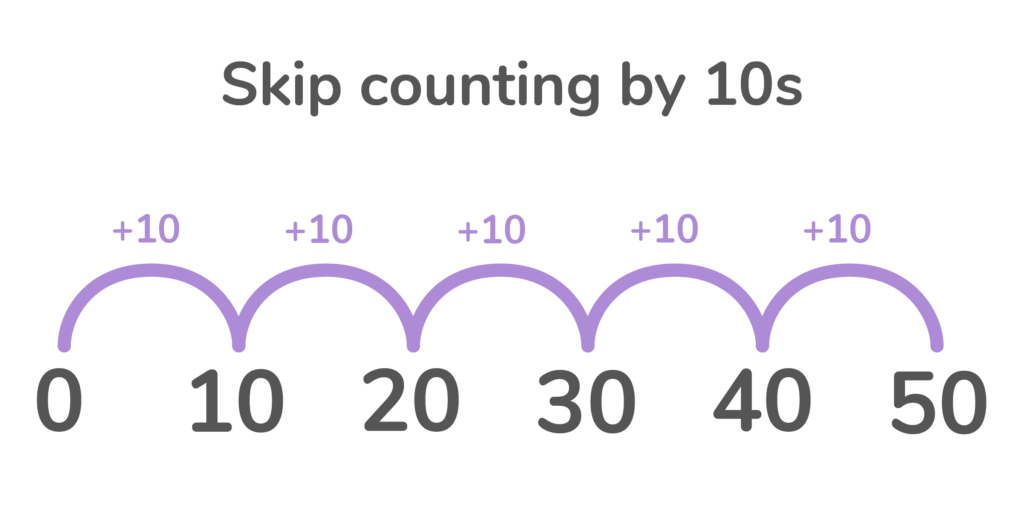

Skip counting by 10s is crucial in early maths education, paving the way for more complex concepts like multiplication and division.

Author
Michelle Griczika
Published
January 2024


Skip counting by 10s is crucial in early maths education, paving the way for more complex concepts like multiplication and division.

Author
Michelle Griczika
Published
January 2024


Skip counting by 10s is crucial in early maths education, paving the way for more complex concepts like multiplication and division.

Author
Michelle Griczika
Published
January 2024


Key takeaways
Table of contents
Skip counting, and especially counting by 10s, is one of the first significant milestones in maths education. It builds a strong foundation for understanding number patterns, place values, and eventually, even multiplication and division!
This guide provides practical strategies to help your child confidently count by 10s and smoothly incorporate the skill of counting by 10 into their daily learning. If you’re ready to support your child in mastering counting by 10s and eventually counting by 100, let’s begin!
Unlock unlimited maths questions
Put your learning into practice with fun exercises + games that are proven to boost ability!

1. Hop and count by tens
Create a hopscotch grid with numbers 10, 20, 30, and so on, up to 100. Have your child hop on each number while saying it out loud. This kinesthetic activity will teach them to count by tens and develop their motor skills.
2. Sing along to the ‘Count by 10s’ song
Encourage your child to sing along to various children’s songs that help them memorize the pattern of counting by 10s in a fun, enjoyable way.
3. Use visual aids
Group everyday items like pieces of fruit, toys, or even colorful cereal pieces into sets of ten and have your child count by 10s to find out how many are there in total.
4. Craft projects
Turn learning into a fun craft project! You could create a “counting by 10s” wall chart or necklace with ten beads on each string. While making these crafts, your child can count by 10s as they add items, reinforcing the concept creatively.
1. Count by 10 during routine activities
Incorporate counting by 10s into routine activities. For instance, while folding laundry, you can sort items into piles of 10 and count them with your child. This practice makes skip counting part of their daily routine, reinforcing the concept frequently.
2. Use a number chart
A number chart is a fantastic visual tool to help your child understand the pattern when they count by tens. Point out how the last digit remains constant (0) while the digit in the tens place increases by 1 each time.
3. Everyday objects
You’d be surprised at how useful everyday items can be when teaching your child to count by 10s. Gather ten pens, ten spoons, ten blocks, or any other objects you have on hand. Group them into sets of ten, and have your child count each group as 10, 20, 30, and so on. This visual method allows children to physically see the concept of counting by 10s and can help them understand it more effectively.
4. Online learning apps
Online learning apps often offer engaging and interactive ways to practice skip counting. Our app for math help offers exercises on counting by 10s and incorporates them into your child’s learning schedule.


Master skip counting to 10 with DoodleMaths. Get questions right, and earn gold stars!
Get even more practice
Fill in the missing numbers in the sequences below
Answer: 20
Answer: 10
Answer: 70
Answer: 20, 30
Answer: 10, 30
Answer: 80, 90
Answer: 10, 20, 40
Answer: 70, 90
Answer: 10, 40
Answer: 90, 100
Counting by 10 is straightforward. Start at 10 and add 10 each time. So the sequence is 10, 20, 30, 40, 50, 60, 70, 80, 90, 100, and so on.
Counting by 10s is an essential skill because our number system is base-10, meaning it’s built around multiples of 10. It also forms the foundation for understanding place value, addition, subtraction, and later, multiplication and division.
There are many strategies for teaching your child to skip count by 10. These include using manipulatives, integrating physical activities such as hopping, singing songs about counting by 10s, using number charts, incorporating counting into daily routines, and utilizing online learning apps. Providing plenty of practice opportunities is key.
Every child is different and develops at their own pace, but generally, children start learning to count by 10s in year 1, around ages 5 to 6. However, you can start introducing the concept earlier if your child shows readiness.
Some children might struggle to remember the sequence or the pattern when first learning to count by 10s. Visual aids, such as number lines or grouped objects, can help them visualize the pattern. Repetition, practice, and patience are key.
Practicing counting by tens will reinforce your child’s understanding. By incorporating these strategies, your child will be ready to tackle counting by 100 or even counting by tens, laying the foundation for more advanced maths skills.


Parents, sign up for a DoodleMaths subscription and see your child become a maths wizard!

Lesson credits

Michelle Griczika
Michelle Griczika is a seasoned educator and experienced freelance writer. Her years teaching coupled with her double certification in early childhood education lend depth to her understanding of diverse learning stages. Michelle enjoys running in her free time and undertaking home projects.

Michelle Griczika
Michelle Griczika is a seasoned educator and experienced freelance writer. Her years teaching coupled with her double certification in early childhood education lend depth to her understanding of diverse learning stages. Michelle enjoys running in her free time and undertaking home projects.
Book a chat with our team
If you’d like to use Doodle’s browser version, please visit this page on a desktop.
To log in to Doodle on this device, you can do so through our apps. You can find out how to download them here: